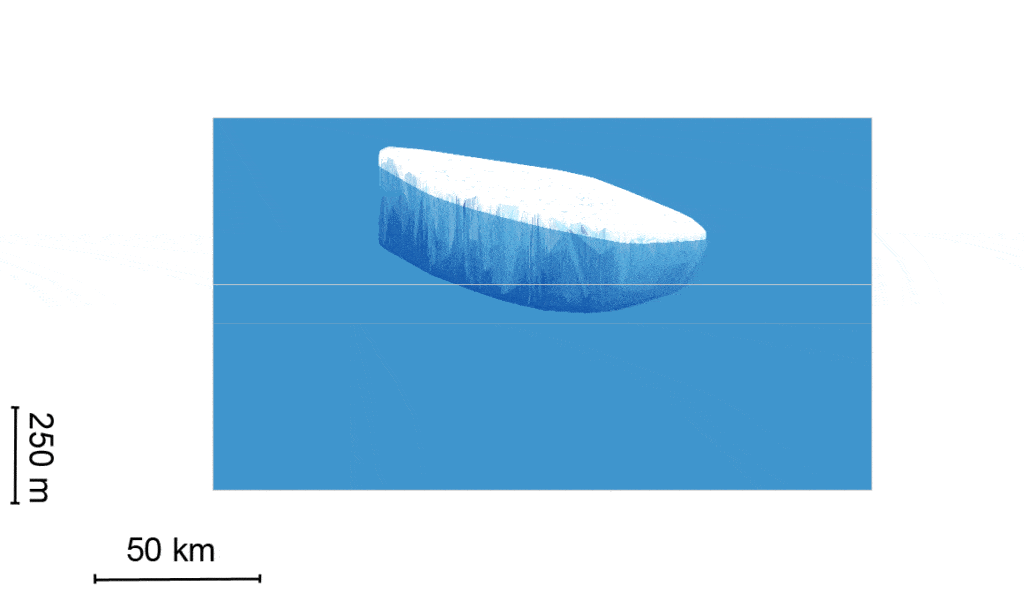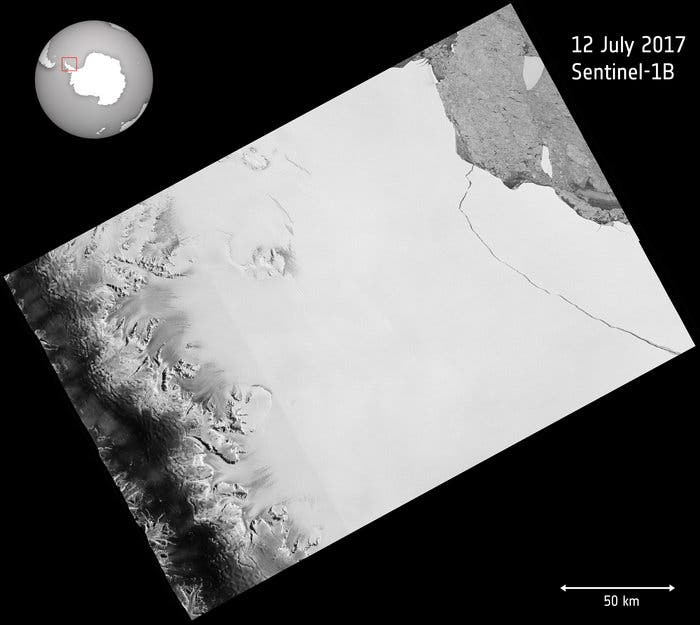
Part of Antarctica’s Larsen C ice shelf broke away, spawning one of the largest icebergs on record. The crack in the ice shelf, which led to the birth of the iceberg, was monitored closely using radar images from the Copernicus Sentinel-1 satellites. Image credits: University of Edinburgh–N. Gourmelen.
A 5,800 square km iceberg weighing an estimated trillion tonnes calved off from the Larsen C Ice Shelf in Antarctica, researchers say. It’s one of the largest in recorded history.
“Its volume is twice that of Lake Erie, one of the Great Lakes,” wrote researchers with Project MIDAS, a research group at Swansea and Aberystwyth Universities in Wales that has been monitoring the situation closely by satellite.
For the past few months, researchers have been keeping an eye on that part of the Antarctic. The massive chunk of ice had been hanging by a thread as a deep cut of ice emerged several years ago, growing bigger and bigger every month. The break was spotted by several remote sensing equipment, including NASA’s MODIS instrument on the Aqua satellite and the ESA’s Copernicus Sentinel-1 mission.

Witnessed by the Copernicus Sentinel-1 mission on 12 July 2017, a lump of ice more than twice the size of Luxembourg has broken off the Larsen-C ice shelf, spawning one of the largest icebergs on record and changing the outline of the Antarctic Peninsula forever. Image credits: ESA.
It was quite useful that we had these tools too because although the calving wasn’t unexpected, the way it happened took scientists by surprise a bit. As Antarctica prepares or the dark polar winter, remote sensing is an invaluable tool, continuing to deliver images of remote areas regardless of the darkness. Through radar and thermal imaging, we should get regular glimpses from the Antarctic area throughout the year.
“We have been expecting this for months, but the rapidity of the final rift advance was still a bit of a surprise. We will continue to monitor both the impact of this calving event on the Larsen C ice shelf, and the fate of this huge iceberg,” added Professor Adrian Luckman from the MIDAS project.
With this calving, about 10% of the area of the ice shelf has been lost. This calving is not necessarily a result of man-made climate change, though temperatures in the Antarctic peninsula have raised dramatically in past decades and this could have played a part. There is an ongoing debate in this sense, but there simply isn’t enough data to draw any definite conclusions yet. Calving occurs naturally in the Antarctic but some researchers believe this happened too fast to be part of a natural cycle. In an email to Washington Post, Eric Rignot, NASA and University of California, Irvine researcher, expressed his clear belief that global warming is at blame.
The Larsen-C rift opening over the last 2 years from #Sentinel1 pic.twitter.com/MT9d3HAw1M
— Adrian Luckman (@adrian_luckman) January 31, 2017
At this moment, opinions in the scientific community are also divided regarding what will happen next. Some believe the shelf will regrow, while others say it will continue to melt away, causing additional calving and even a total collapse of the shelf. It seems quite likely that this calving greatly reduces the stability of the area.
For now, it’s not clear what will happen to the iceberg. It could stick together, it could break off. For now, it means increased hazards for nearby vessels. The area is outside of major trade routes, but cruise ships from South America regularly venture nearby. Scientists will continue to monitor the area to assess its evolution.
“The iceberg is one of the largest recorded and its future progress is difficult to predict,” said Adrian Luckman, professor at Swansea University and lead investigator of Project MIDAS, which has been monitoring the ice shelf for years.
“It may remain in one piece but is more likely to break into fragments. Some of the ice may remain in the area for decades, while parts of the iceberg may drift north into warmer waters,” he added.









